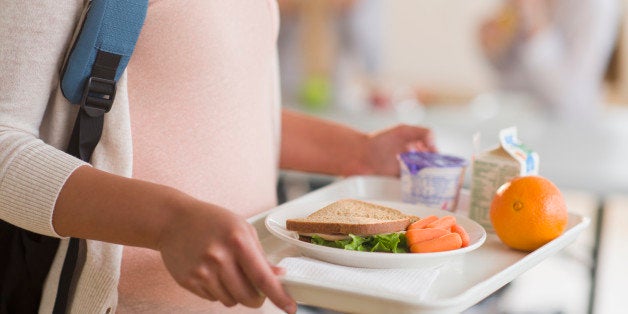
It's impossible to characterize an entire nation's eating habits. On the other hand it is safe to say that the patterns offered in the American preschool and school system leave much to be desired.
Pamela Druckerman's Bringing Up Bébé has lots of admiration for the French parenting style. Druckerman, who is raising three kids in Paris, describes a nationwide framework of politeness, patience and knowing-one's-place, which sounds, well, like a gross generalization. I've lived in three countries, and in each, parents were as varied as Noah's Ark. Parenting is a messy, imprecise art, and despite parents' best efforts we all make many mistakes. I'm sure we have plenty to learn from French parents -- but there's also plenty to learn from your next-door neighbor and from your aunt, too.
Yet when it comes to food education in school -- a government-supervised program -- we actually can compare the systems with some accuracy.
Lunch at a French preschool
Druckerman scores a spot for her daughter in the nearby daycare (crèche), a government-run, all day, affordable program for 3-month- to 3-year-olds. Druckerman is won over by the food and describes the "dining experience" at the crèche in detail. The week's menu is posted near the entrance, and every lunch is served in four courses: a cold vegetable starter, a main dish with a side of grains or vegetables, a cheese course with a different cheese each day, followed by dessert of fruit or fruit puree. Lunch is a 30-minute affair, even at the daycare age-group level, and it is cooked in house, from scratch.
Druckerman attends the Parisian menu committee to better understand how these daycare menus are constructed. A few principles are apparent: Variety is important, and there are very few repeats. Each ingredient is prepared in several different ways, so kids will try the full range of what spinach can taste like and have many occasions to give new foods a chance. There are no "kid's foods" -- food isn't dumbed down and there are no chicken nuggets.
Karen Le Billon used to post the school lunch menu from different areas in France in her blog, French School Lunch Menus and her observations are similar. The menus demonstrate the veggies first principle -- first course is when kids are most hungry, and will appreciate almost anything -- there are no sweetened drinks or flavored milks and there are no vending machines at schools. The meals are usually cooked at the school kitchen, but some schools outsource the cooking to private companies, who, nevertheless, make the food from fresh ingredients -- food is never prepared in a factory.
Now take a look at the June menu of the Philadelphia School District. I don't want to pick on any specific item, but it does read like a fast-food menu, not like a freshly made meal.
I devoted many posts to our School Lunch Program and to the fight to improve nutrition at school. The 2010 Healthy Hunger-Free Act was a step in the right direction: Under the new guidelines menus doubled fruit and veggie servings, increased whole grains, and set upper limits to salt, trans-fat and calories.
Yet even the improved lunch is one of highly processed foods -- very few schools actually cook food from scratch -- and tomato paste on pizza counts as a vegetable. And now there's a threat of a step back: members of the House of Representatives want to provide exemptions from these standards and lower the quality of food if a school is losing money.
Snack often nation
The French eating pattern, which Druckerman says is observed from very early on, consists of three meals and one goûter (late-afternoon snack, quite similar to the British tea time). There are no snacking times or snacks at daycare, preschool or school.
How one divides daily calories can be a matter of preference, so if snacks consist of good food should it matter that American kids are trained to eat all day? That most preschools feed kids every two to three hours and that there's a vending machine in most schools?
The answer, I think, is that it does matter. Arriving at the meal hungry makes the introduction of new and healthy foods much easier. Knowing that if you skip breakfast there's nothing to eat until lunch encourages kids to eat breakfast. And unfortunately, snacks, even the healthified ones, are usually not exactly food.
So yes, there is wisdom in the way French schools feed kids. Perhaps that's part of the reason why 14 percent of French kids are overweight (still, way too many) while a whopping third of kids in the U.S. are overweight or obese.
We can definitely learn from others.
Dr. Ayala